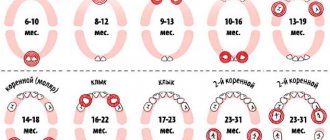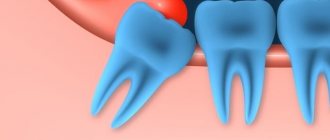At 4 months, primary teething often occurs. The child cannot independently communicate what exactly is bothering him, so strong crying appears. It gets worse at night. Some children tolerate this period calmly, while in others it manifests itself with negative symptoms, pain, and increased body temperature. If a child’s baby teeth begin to erupt before 4 months, it is necessary to look for deviations in health. Normally, they should appear at 4-6 months, so parents should monitor for symptoms.
Norm or pathology
Can teeth be cut at 3 months? The earliest age for the eruption of the first elements is considered to be three months of age. Dentists consider it normal for the first teeth to appear at 3 months of age. If the incisors appear earlier than the expected period, then the child should be shown to a therapist. The early appearance of elements on the surface of the gums may signal hormonal disruptions occurring in the body.
The appearance of baby teeth on the surface is accompanied by a number of distinctive symptoms:
- Pain in the gums. Because of this, the child puts fists and foreign objects into his mouth. At this moment, it is important for adults to ensure that there are no small toys or objects near the child that could get into the respiratory tract.
- Deterioration of the oral cavity. The gums swell and redden, becoming more sensitive to external irritants. In some cases, due to teething, the child may experience slight redness of the throat.
- Irritability and increased tearfulness of the baby. The symptom is associated with constant pain in the area of the eruption of the element. At this moment, children become more active and faster.
- Disorders of the digestive tract, manifested by loose stools, regurgitation, and rare bouts of vomiting.
- Temperature increase. The symptom is due to the fact that when teething, the newborn’s body is vulnerable to bacterial and viral pathogens.
How to help your baby
If a baby starts teething at 2 months, in addition to fatigue due to sleepless nights, parents feel worried about their baby. Since he suffers from pain, discomfort, eats little and sleeps poorly, it is necessary to help relieve unpleasant symptoms. To do this, use the following methods:
- Massage the gums. You must first wash your hands thoroughly. The massage is done with the tip of your finger. It is worth trimming your nails to avoid damaging your gums. Massaging helps relieve pain. The degree of effectiveness of the method can be determined by the child’s reaction.
- Cold is applied. Regular teethers, which are sold in pharmacies and offered to older children, will not be chewed by a baby at the age of two months. In this case, he can cool the pacifier or apply a gauze pad to the problem area. It is pre-moistened with cold water or chamomile infusion, which helps relieve inflammation.
- Lubricate the gums with anesthetic gels. For example, “Kamistad” or “Kalgel” are products that can be used even at an early age.
- They give antipyretic and painkillers based on ibuprofen and paracetamol. Candles are given to 2-month-old babies. This could be, for example, “Efferalgan”.
During the teething period, it is important to provide the baby with proper care. It is necessary to keep the pacifier clean. Saliva should be wiped off only with clean napkins. The skin around the mouth should be lubricated with a special baby cream. You also need to walk more - fresh air will only do you good. But it is better to avoid places with large crowds of people so that the baby does not catch an additional virus.
If a child’s teeth appear early, if he is breastfed, it is worth visiting a dentist. The fact is that the risk of developing bottle caries in this case is quite high.
Scheme for cutting elements for children
Dentists have drawn up a specific scheme for the formation of primary occlusion in children. However, it is necessary to remember that each baby’s body is individual, and the teething dates established by doctors may deviate up or down by several months. Pathological signs of bite formation in babies include early eruption of incisors (up to 3 months of age) and the complete absence of elements in the oral cavity by 12 months.
The standard scheme for the formation of bite in children is as follows:
- 5–7 months – lower front incisors;
- 8–10 – upper incisors;
- 10–12 – upper lateral incisors;
- 11–13 – lower lateral incisors;
- 12–15 – upper and lower molars;
- 17–22 – canines (upper, then lower);
- 25–30 – upper and lower molars.
Pattern of tooth growth in infants
If a child is cutting teeth at 3 months, then these should be the front pair of incisors. If the side elements are shown first, then it is necessary to show the baby to the dentist. The symptoms corresponding to the process depend on the characteristics of the child himself. In some children, the elements appear completely unnoticed, in others they cause crying, fever, etc.
Alarming symptoms
Many signs of teething are harmless and go away on their own once the incisor comes to the surface. However, some signs may indicate the addition of bacterial or viral diseases against a background of weakened immunity.
Reviews of Dentokind for teething up to one year
Normal signs of the condition include:
- Profuse salivation. The symptom is observed in almost all children under three months. It does not require treatment for the child.
- Skin irritation near the chin. The symptom is caused by increased salivation during teething. It is enough to use an emollient cream every day at night to eliminate skin redness.
- The child's desire to breastfeed frequently. During feeding, the baby scratches its gums on the mother's nipple.
The list of alarming symptoms of teething includes:
- refusal to eat (more than 3-4 feedings);
- persistent diarrhea (may indicate an incipient intestinal infection);
- constant crying of the child.
Small bruises (hematomas) may appear in the eruption area. They dissolve quite quickly if you apply a compress to the problem area.
Symptoms of teething
There are common signs that indicate teething at an early age.
Tears, anxiety
The baby has the following signs:
- severe crying, whims;
- decreased appetite, refusal to drink food and water;
- letting go of the breasts while eating.
Symptoms are formed due to changes in the gums. As baby teeth begin to damage them, an inflammatory reaction is formed. It is accompanied by characteristic signs:
- pain;
- edema;
- inflammation.
Increased sensitivity of the gums causes severe anxiety and discomfort.
Increased salivation
With increased salivation, the following signs are formed that parents should pay attention to:
- copious amounts of saliva that may leak from the mouth;
- the child pulls objects into his mouth, bites and sucks.
Increased salivation does not always develop during teething. This may be a symptom of digestive problems, the development of oral fungus, and other diseases.
Loose stools
Impaired stool formation often occurs during teething. The condition is aggravated by the fact that from 4 months, most pediatricians recommend introducing the first complementary foods little by little. Therefore, parents do not always understand what exactly caused diarrhea. It is necessary to carry out differential diagnosis with the following conditions:
- eating poor quality food;
- inflammatory diseases of the gastrointestinal tract;
- intestinal infection when infected with pathogenic bacteria.
You should sound the alarm and consult a doctor only in the following cases:
- diarrhea occurs 3 times a day or more often;
- stool does not return to normal within 3-7 days.
In addition to the consistency of the stool, you need to pay attention to its contents. The presence of inflammatory or infectious pathologies of the gastrointestinal tract can be suspected in the presence of impurities of mucus, pus, and blood.
The following stages of examination of the child are distinguished, which help to differentiate normal teething from an intestinal infection:
- the baby is first calmed down so that there is no strong crying;
- placed on a hard surface, such as a changing table;
- palpate areas of the child’s abdomen;
- if there is no crying, you remain calm, your stomach is soft, there is no reason to panic;
- if the stomach is hard, crying immediately appears, you need to consult a pediatrician, the child may be developing an intestinal infection.
Digestive disorders are often accompanied by vomiting and excessive regurgitation. The signs are also characteristic of the teething period.
Increased gum sensitivity
A four-month-old baby always experiences increased sensitivity when teething gums. It is accompanied by the following symptoms:
- swelling of soft tissues;
- severe redness;
- increased sensitivity;
- pain, itching, burning.
Teething brings great discomfort, so parents should remain calm around it. Mom should not worry, she needs to remain calm. If it is tense, the baby's condition will worsen.
At 4 months, the child has not yet learned to eat food in pieces. Therefore, it is forbidden to give him crusts of bread, large pieces of carrots and any other food that he might accidentally bite off and swallow. This risks causing the child to choke and begin to choke.
Less commonly, large pieces of food at this age can lead to the formation of small hemorrhages in the gums. They go away on their own, but can frighten young parents.
Fever, cough
The table shows the main signs by which you can differentiate between colds and teething.
| Symptom | Teething | Cold, infection |
| Hyperthermia | The temperature cannot rise above 38°. It can only last for 4 days, then it goes away on its own | With a cold, low-grade fever is observed. If the infection is serious, the temperature rises to 38-40° |
| Malaise | No | The child becomes very weak and refuses to eat food for a long time. |
| Cough | No | Since a 4-month-old baby spends more time lying down, sputum is difficult to come out, which is why a wet cough develops. If it is not treated promptly, wheezing develops in the trachea and bronchi due to the accumulation of sputum. |
| Rhinitis | A small mucous discharge from the nose that may drain into the throat. Symptoms last 2-3 days, then go away on their own without taking medications | Strong, long-lasting, not eliminated without medication. Mucous discharge may turn purulent and is accompanied by a yellow or green tint |
Strong, persistent crying, even after taking painkillers, may be characteristic of inflammatory processes in the ears. If otitis is suspected, contact an otolaryngologist; do not carry out self-therapy.
Factors affecting tooth growth
The speed of formation of a mixed bite depends on several circumstances:
- baby's genotype;
- performance of the thyroid gland;
- gender;
- severe infectious and viral diseases suffered in the past;
- duration of natural feeding;
- the presence of congenital diseases.
You also need to monitor the period of eruption of molars. They should come out to the surface of the gums only after the milk unit falls out. Otherwise, a mandatory visit to the dentist will be required. Early loss of milk elements is also undesirable, as this negatively affects the proportions of the baby’s jaw and his bite in the future.
Reasons for the atypical timing of the eruption of elements
Only a dentist can accurately determine the causes of abnormal teething in children. However, there are several common violations that lead to the problem:
- improper metabolism;
- lack of calcium in the body;
- disturbances in the functioning of the endocrine system;
- gastrointestinal pathologies;
- incorrect direction of the tooth axis.
Anomalies of the dentition can be associated not only with the timing of the appearance of elements, but also with the color, location, and size of the units in the row. If a child is already born with teeth, they are usually removed. Such situations are diagnosed quite rarely, and they indicate intrauterine disorders in the baby.
How to help a child?
It is impossible to speed up the process of teeth appearing - sometimes it drags on for weeks (for one tooth). The maximum that parents can do is to reduce the number of unpleasant symptoms.
- Vibucol suppositories can be used as a sedative.
- As a pain reliever - children's versions of Nurofen and Panadol.
- As a hygiene product for the oral cavity - gel-based anti-inflammatory toothpastes for children from 0 years old. Asepta Baby paste is designed for little ones. It does not contain fluorides, parabens, or abrasives. Gently cleans teeth, saturating them with calcium. The paste tastes good and is safe - if the child wants, he can swallow it without harm.
Read more about ways to help your baby during teething in other articles in this section.
Ways to alleviate the condition
The formation of a bite is often accompanied by an increase in temperature. Therefore, parents should always have antipyretic drugs in their medicine cabinet (Panadol, Nurofen, Ibuklin). They not only reduce the temperature, but also relieve pain associated with tooth growth.
The love and attention of parents will allow the child to cope with the problem. The baby should be put to the breast and picked up as often as possible. Special teethers with gel will help satisfy your baby’s desire to scratch his teeth.
You need to choose small devices so that the child can comfortably hold it in his hand.
Pediatricians advise cooling teethers with cold water before giving them to a child. Instead of toys, you can give your baby chilled pieces of apple or carrot. At the same time, parents should carefully monitor that the baby does not bite off the product and does not choke on it. In parallel with this, local anesthetics can be used.
On the pharmacological market there are many drugs in the form of a gel that relieve pain during the appearance of teeth - Kalgel, Kamistad, Cholisal. Additionally, the gels have an anti-inflammatory effect, which also alleviates the child’s condition. The analgesic effect occurs 2-3 minutes after using the drug.
Help a child
When negative symptoms develop, which bring a lot of discomfort to the child, lack of appetite and sleep, therapy is recommended. It should be gentle so as not to harm the body at an early age.
Elimination of elevated temperature
If a child’s body temperature rises and remains at 38°C or higher, give one of the following medications:
- Nurofen;
- Cefekon D;
- Children's Paracetamol;
- Panadol.
In total, there are 2 active ingredients with different properties:
- Paracetamol
. The volume of active substance is calculated based on the child’s body weight. The maximum daily dose is 60 mg per 1 kg of body weight. Take before meals for a quick effect. If you need to calculate a single dose, calculate 15 mg per kilogram of body weight. After taking an antipyretic drug, the next dose can be taken no earlier than 4 hours later. Young patients are given drugs in the form of syrups. They have a sweet taste, so the child swallows them without problems. If the body temperature is too high, it is recommended to give suppositories. The active substance is quickly absorbed through the intestinal mucosa, so the temperature drops faster. - Ibuprofen
. This is a more potent substance, so 6-8 hours should pass between doses. Only 3 doses are allowed to be given in 1 day. Calculation is made for 1 dosage from the ratio of 10 mg of the drug per kilogram of the child’s body weight. If you need to calculate the daily dose, use a ratio of 30 mg of the drug per kilogram of body weight.
If side effects occur, you must stop taking the drug. Any type of negative reaction that could lead to a deterioration in the baby’s well-being is not acceptable.
Antipyretic drugs are recommended to be used after a general examination of the baby and anamnesis. This is what the pediatrician does.
Treatment of a runny nose
For the treatment of a runny nose, the following gentle remedies are recommended, which are allowed for children from birth:
- Derinat;
- Nazivin baby;
- Aqua Maris.
Nasal drops are used only as a last resort, as they are vasoconstrictor drugs. The maximum intake should be no more than 5 days.
Pain in gums
The table shows the optimal drugs for eliminating pain in the gums.
| A drug | Characteristic |
| Kalgel | Apply a small amount of gel to the gums. Application is carried out for no more than 6 days. Allowed to be applied 4-5 times a day |
| Kamistad baby | You can use a cotton swab or your fingers to apply the product. Reception is carried out no more than 3 times a day |
| Holisal | Soft tissues are pre-wiped with a cotton pad and rubbed in 3 times a day. |
To make teething easier, special toys are provided. They are called teethers. It is recommended to pre-treat them with boiling water to prevent the spread of bacterial microflora.
During teething it is not recommended to wean. This will be very stressful for the child. Breastfeeding helps him calm down.










